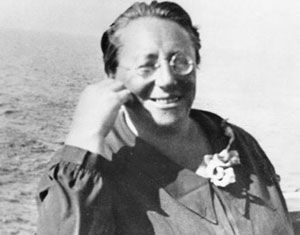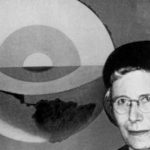Ultimate Emmy Noether Biography With Interesting Facts

This is the ultimate biography of German mathematician Emmy Noether. On this page, you can learn what she is famous for and watch relevant video. Please share this page with your friends and family members.
Table Of Contents
Interesting Emmy Noether Facts
Emmy Noether was a German mathematician who lived from 1882 to 1935. Her academic contemporaries like Albert Einstein, Pavel Alexandrov, and Norbert Wiener described her as one of the most influential women in mathematics. According to the Emmy Noether biography, her scholastic career began at Erlangen University where her father was a professor. She initially wanted to teach English and French. However, she changed her field of studies to mathematics soon after enrolling in the university.
Another one of the interesting Emmy Noether facts is that she spent seven years lecturing at the university without pay. The university did not approve of her lecturing at the institution. She had to teach classes under the name of one of her male counterparts. She finished, presented, and defended her dissertation in 1907. Her career teaching mathematics at the university level began officially in 1919 when she was finally approved for a teaching position under her own name.
As is reflected in her official biography, she studied and taught during a time when women were typically shunned in the world of academia. She endured and overcame stereotypes and obstacles that prevented many women with the same level of intelligence from prevailing in the field of mathematics. Because of her persistence, she stands out as an early feminist icon. She is still remembered throughout the world. Her contributions to mathematics continue to be studied and utilized by instructors in high schools and universities when teaching students.
Exciting Video Biography
Watch brilliant Google Tech Talk that discusses the work and legacy of this great mathematician
The Greatest Of Emmy Noether Accomplishments
Emmy Noether is most respected for her efforts to change the manner in which mathematics are regarded. Before her efforts, mathematics were taught in a complex manner. She advocated breaking down mathematical problems into simple pieces so that they can be understood and solved better.
Another one of the more notable Emmy Noether accomplishments is the fact that she essentially created the concept of abstract mathematics. Her advocacy of abstract mathematics at the time was considered to be controversial and dangerous. Eventually her discoveries carried over into geometry, logic, and other academic fields.
Noether received numerous awards including the Ackermann-Teuber Memorial Prize. She was honored with these awards during a time when women academics were thought of as inferior. She was also invited to lecture at the International Mathematics Conference in Zurich. Furthermore, she was the first female academic to be invited to give a lecture at this venue.
Finally, she surpassed the accomplishments of her father. Her father, Max Noether, was a highly regarded mathematician. She was thought of as nothing more than his daughter and someone who would not amount to his level of standing. However, she earned more awards and became better known than her father. She transcended gender stereotypes of her time and earned respect and equal standing with her male academic counterparts.
Emmy Noether Contributions To Math You Need to Know
Emmy Noether made numerous significant contributions to the field of mathematics. These efforts dated from 1908 through 1935 shortly before she died. Her first major contribution is named after her. Noether’s Theorem was proven in 1915. It centers on the theory of constants of motion. It likewise has a corresponding conservation law. This theorem is still used today in abstract algebra, theoretical physics, and all levels of calculus.
Another one of the major Emmy Noether contributions to math is her discovery and identification of rings and groups. She identified rings and groups as two of the most basic objects in math. She defined rings as a set of elements plus two different operations. A group is a set of elements and a single operation. The theory of rings and groups are still taught today as she outlined for the fields of abstract algebra, calculus, and physics. In 1943, mathematician Claude Chevalley created what is now known as the Noetherian ring, which further proves Noether’s theory that every ideal is finitely generated in a ring.
She also created three separate epochs from 1908 to 1935. The three epochs all revolve around abstract math and physics. They are considered to be important to the field of mathematics because they discovered and defined theories like the Galois and the elimination theories. She accomplished work on her third epoch theory with the assistance of fellow mathematicians Artin, Brauer, and Hasse.
Emmy Noether Personal Life
Emmy Noether was born in 1882 in Erlangen, a town in the Bavarian region of Germany. She was the oldest of four children and her parent’s only daughter. Her birth name was Amalie in honor of her mother and grandmother. However, she never used it as her first name and instead chose to be called by her middle name of Emmy. She had three younger brothers, Alfred, Fritz, and Gustav. As a child, she learned traditional lessons for girls that included keeping house and baking.
Her primary school teachers never regarded her as particularly intelligent. They did note, however, that she was clever and showed good logic. According to Emmy Noether biography, she could solve puzzles easily. She was near-sighted and had a lisp when she spoke. Still, she was well-liked by her classmates. However, she did not want to pursue domestic skills like the other girls of her age.
After she finished her primary education, she passed the required examinations to teach French and English. She decided not to teach and instead chose to go to university. In addition to attending and teaching at Erlangen University, she also taught at the University of Gottingen, Moscow State University, and Bryn Mawr College at Princeton University. She was expelled from the University of Gottingen for being Jewish after Hitler rose to power. Students at the university protested her and other Jewish professors by shouting “Aryan students want Aryan mathematics and not Jewish mathematics!”
Emmy Noether Doctoral Students
During her career, Emmy Noether mentored and oversaw the doctoral pursuits of 16 individual doctoral candidates. Several of her students went on to enjoy illustrious careers in mathematics and science. One of her earliest doctoral candidates whom she oversaw was Grete Hermann. Hermann was a female mathematician and philosopher whose work centered on physics and education as well as math and philosophy. She is most famous for her discovery of the ideal membership of polynomial rings. She was also a political activist and took part in underground efforts to undermine the Nazi movement in Germany.
Noether also oversaw the studies of Max Deuring. Deuring is well-known for his contribution to the discovery of elliptical curves. Noether was so impressed with Deuring when he was an undergraduate mathematics student that she chose him personally to mentor during his doctoral work. When she was expelled from the University of Gottingen, she asked the university leaders to give her position to Deuring. Deuring enjoyed a long academic career and died in 1984.
Chiungtz Tsen was one of Noether’s international doctoral students whose research and dissertation she oversaw. Tsen is best known for his research in quasi-algebraic closure. After he received his Ph.D. in Germany, he returned to China. He had to flee his hometown when Japan invaded it. So he settled in another Chinese city called Xikang and created his own theorem called Tsen’s theorem. He also founded the National Xikang Institute of Technology. Tsen died of stomach cancer in 1940.
Emmy Noether Death
Emmy Noether came to the U.S. to teach at the Bryn Mawr College at Princeton University. In 1935, she discovered a lump in her pelvis. Doctors who examined her found that the lump was a large cyst. The cyst was reported to be the size of a cantaloupe. They operated on her and found more tumors in her uterus. They attempted to remove all of the cancer during the surgery and then restricted her to bed rest to help her recover.
At first, it appeared she would recover well as she showed signs of improving. However, within days of her surgery, she developed a high fever. Her temperature rose to as high as 109 degrees Fahrenheit. During this high fever, she was incoherent although she did say “It is not easy to say what had occurred in Dr. Noether.” Her doctors attributed her rambling to a brain infection brought on by the high temperature inside of her body.
On April 14, she lapsed into unconsciousness and died. Her counterparts at Bryn Mawr received her death with shock and sadness. Because she had no surviving family members, with the last of her brothers dying in 1889, her peers at the college organized a memorial service for her. They held her service at College President Park’s house. Academic greats like Einstein and Alexandrov memorialized her in written tributes that appeared in publications around the world. She was cremated and her ashes were interred under the walkway at the M. Carey Thomas Library at Bryn Mawr College.
Emmy Noether Memorials
Emmy Noether is remembered in numerous tributes that still exist today. The Association for Women in Mathematics, which is headquartered in Fairfield, Virginia, hosts a Noether Lecture every year. The lecture series began in 1980 and is held at the American Joint Mathematics Meeting in January every year.
Additionally, the University of Siegen named a campus after her. The campus is dedicated to the university’s mathematics and physics studies. The German Research Foundation has its own Emmy Noether Program. In Erlangen, a school is also named in her honor. The city also named a street in honor of her and her father. The Perimeter Institute for Theoretical Physics has its own Emmy Noether Visiting Fellowships program. It also has the Emmy Noether Council. Similarly, the Israeli Bar-llan University, which was co-founded by the Minerva Foundation and the German Government, has its own Emmy Noether Mathematics Institute in its Mathematics and Computer Science department.
Additionally, Noether has a moon crater and an asteroid named after her. The Noether crater is located on the far side of the moon. The asteroid is officially known as the 7001 Noether. Finally, the fictional character Emmy Nutter in “The God Patent,” written by scientist Ransom Stephens, is named after Noether.
We hope you enjoyed this Emmy Noether biography and learned something new from it. Please share it on social media with your friends and family members if you did. Thank you for reading and have a wonderful day.
Biographies Of Other Famous People
If you are a history buff or love interesting facts about famous people, you will definitely enjoy reading the following two biographies: choose one of them and enjoy the history: Ultimate Inge Lehmann Biography or Adolphe Sax Biography
- Met Gala 2024 Uncovered: The Shocking Space Alien Story! - May 9, 2024
- Mufasa The Lion King: A Fresh Roar or Same Old Tale? - May 3, 2024
- Snow Jokes That Guarantee a Blizzard of Giggles! - February 26, 2024


















